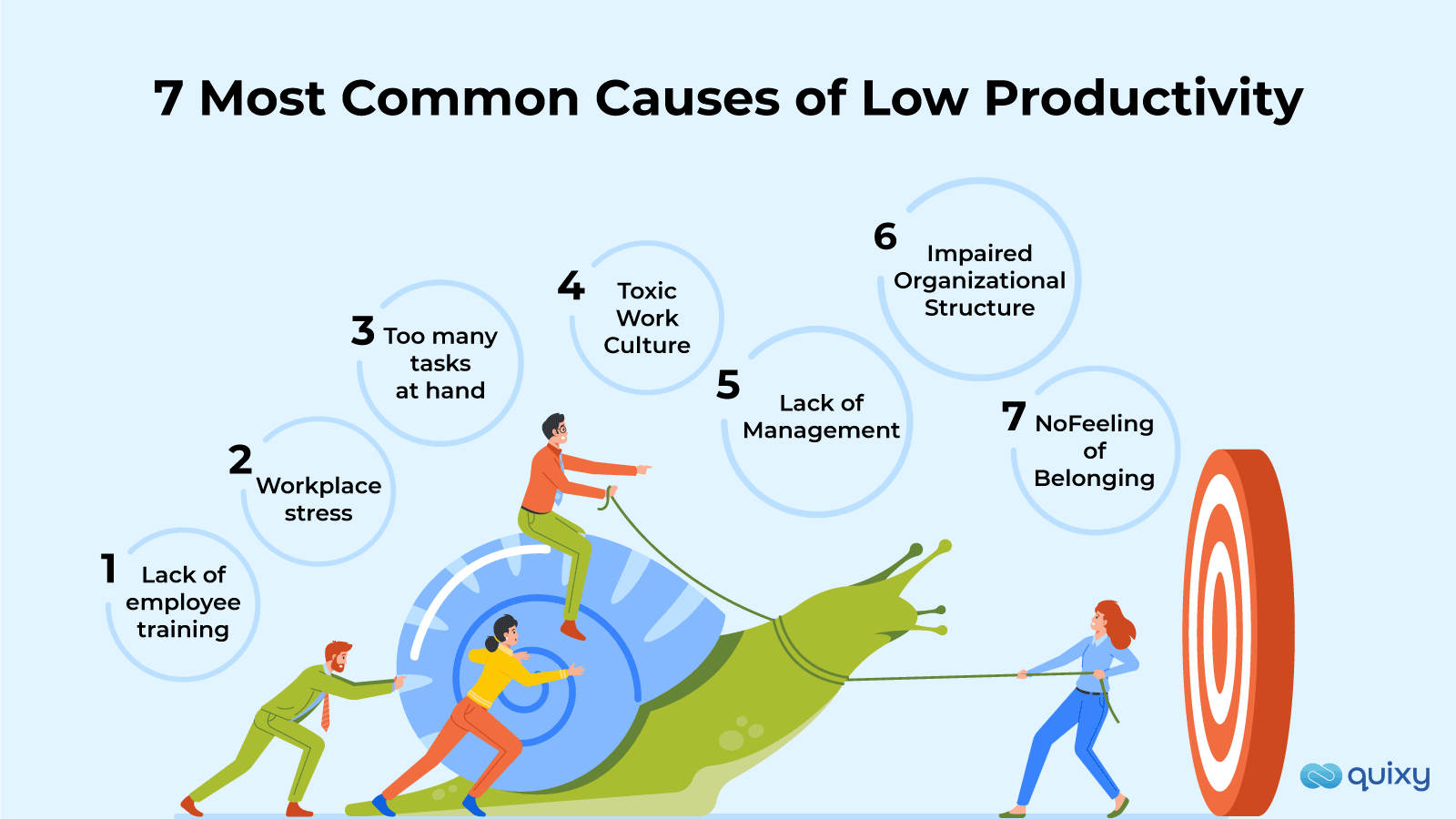
We often hear CEOs and Managers saying that low levels of productivity will lead to decreased efficiency, lack of time management, missed deadlines, inaccuracy in work, and hence no growth.
They are indeed correct. However, it is necessary to find the root causes of low productivity at work and, finally, how to manage higher productivity and efficiency.
Understanding the causes of low productivity at work is the first step in resolving the problem.
The seven most common causes of low productivity at work are listed below, along with a few productivity tips to overcome these causes at the end.
7 Most Common Causes of Low Productivity

1. Lack of employee training
Lack of adequate employee training is the most frequent root cause of low employee productivity. Time and resource management are automatically hampered when employees are not properly trained.
Untrained employees will inevitably consume more time and resources than are required and end up producing low levels of productivity. They will require supervisors to ensure that their tasks are being completed, and you will need other employers to review, correct, and correct any errors in their work.
2. Workplace stress
Imagine your coworkers never being able to concentrate on one thing because they constantly think about the next task they need to complete.
When worries about their jobs plague coworkers, they become disoriented, lose focus, and cannot meet their tasks as effectively as possible. They might jump from one task to another when deciding how to use their time and finish as much work as possible. As we are already aware, this results in work stress, which indicates more work done (under pressure) but with less efficiency. This is one of the major causes of low productivity.
Also Read: Challenges in Increasing Employee Engagement
3. Too many tasks at hand
If you search whether multitasking is beneficial or detrimental online, you will undoubtedly come across a wide range of sources, each of which will have a different opinion.
If you are the CEO or senior manager of a company, you probably want to assign as many tasks to your employees as possible, believing that this will ensure that they never have anything to do.
Consider that two projects (A and B) must be done, and it will take a week to finish each. Now imagine that your coworkers begin juggling the two projects without paying particular attention to either. After two weeks, both projects will be completed, but attempting to complete as much work as possible will cause Project A to be delayed by an entire week, with no advantages to Project B.
Instead, they will be able to complete Project A in one week and Project B in two weeks if they focus on one project at a time. Time management can play a key role while enhancing productivity at work.
Also Read: Best Productivity Tools to add more hours to your day!
4. Toxic Work Culture
Often, toxic behavior at work results from individuals attempting to manipulate and sabotage the workplace. Team members negatively impacted by this kind of behavior will be forced to consider their long-term futures within the organization due to their unhappiness.
This is more common in larger organizations where some staff members employ devious strategies to advance their careers and move up the corporate ladder. Employees who engage in toxic behavior may experience stress in the long run, which can result in low productivity, work ethic, and workflow.

5. Lack of Management
Poor management is one of the major causes of low productivity. According to studies, almost 80% of workers have encountered poor management, which demotivates them from giving their all to the organization for which they work.
There are still a lot of managers in organizations who like to micromanage their employees. If your business realizes low employee productivity at work, it is often a sign to evaluate your management. Today’s businesses need leaders to drive change and move their organizations forward.
Also Read: 50+ Powerful Employee Productivity Statistics that will make you think
6. Ineffective Organizational Structure
A significant contributing factor to your employees’ low productivity maybe your company’s poor organizational structure. This can take many forms but typically occurs when you don’t fully optimize your workflow.
Very frequently, especially in larger organizations, there are circumstances where there is a lack of coherence between departments. The likelihood of low levels of productivity at work will significantly increase even if there is a small amount of confusion about who is in charge of what or what is to be done next.
Establishing a proper structure can help you go a long way in keeping the productive juices for your employees running.
Also Read: 20 must-have No-Code Productivity Tools to boost your Efficiency
7. No Feeling of Belonging
The fact that employees don’t feel like they belong at the company they work for could be a significant factor in their low levels of productivity at work. Every CEO or senior manager must make sure that the workplace culture welcomes new hires and does not leave them feeling undervalued. If not, there is a greater chance that your new workforce will be less productive than the rest simply because they will feel out of place.
One study in the financial industry, for instance, found that only 20% of existing workers felt highly valued at work. When employees at one company feel like their efforts aren’t valued, it lowers productivity because it demotivates the workforce.
The sense of community at work greatly increases workplace productivity. Employees’ spirits are raised when they converse and interact with one another while working. Lack of social interaction among coworkers can result in loneliness and isolation. They might become discouraged, which would result in low productivity.
Social gatherings, open communities, etc., should be organized to fulfill employees’ social needs.
Explore Infographic: 7 Key Statistics on Workplace Productivity and how Automation can help
Top 7 ways of overcoming low productivity at work
1. Raise productivity with employee training
The solution to solving the issue of low employee productivity and raising productivity at work is ensuring every employee receives the proper training.
However, if an employee consistently falls short of expectations despite receiving training, you may need to think about moving them to a different department or even firing them.
As a manager, ensure the new and existing employees are well-trained and equipped to ensure greater productivity for the business.
Also Read: Literally the Best Google Chrome Extensions for Productivity
2. Promote better management and supervision
Your responsibility is to ask your staff whether their managers motivate them to perform at the levels required for success or demotivate them.
If you are an employee, your manager might lack the necessary training or need to learn better management techniques for the staff members they are responsible for.
In either case, your responsibility as a business leader is to spot weak points in the relationship between management and employees and work to fix them to boost results and avoid the cascading effects of low productivity.
To overcome the causes of low productivity at work, adopt a flat organizational structure in which each employee is free to contribute to developing new concepts, strategies, and plans.
Also Read: Top 47 No-Code and other Sales Tools to Boost Productivity, Efficiency, and Revenue
3. Streamline Communication
One of the significant ways to streamline communication is by holding daily stand-up meetings where your team communicates the tasks that have been completed, are currently being worked on, or will soon begin.
After this, ensuring all complaints are handled equally and consistently by establishing a grievance policy is another way to improve productivity and streamline communication.
As a manager, ensure that the employees in your company feel appreciated by communicating words of praise like “well done,” “great work,” and “thank you.” Asking your employees questions like
How can I help you? What are the resources you need to succeed? etc. can aid open communication in the organization and help employees share their thoughts so that management can quickly step up to help them.
4. Set Clear Goals and Expectations
One of the key factors contributing to low productivity is often a lack of clarity regarding goals and expectations. Employees need to know exactly what is expected of them and what their priorities are. As a manager, make sure you communicate clear and achievable goals to your team. Break down larger objectives into smaller, manageable tasks, and set specific deadlines for completion.
Regularly review progress with your team and provide feedback on their performance. This will help keep everyone on track and motivated. When employees have a clear understanding of what needs to be accomplished, they are more likely to stay focused and productive.
5. Encourage Work-Life Balance
Believe it or not, encouraging work-life balance can actually lead to increased productivity. Overworked and stressed-out employees are more likely to burn out, leading to lower efficiency and motivation. As a manager, promote a healthy work environment by respecting employees’ time off, encouraging breaks during the workday, and discouraging excessive overtime.
Implement flexible work arrangements if possible, allowing employees to manage their schedules effectively. This can improve job satisfaction and overall well-being, leading to higher productivity levels when they are at work.
6. Provide Adequate Resources and Tools
Low productivity often stems from a lack of necessary resources or outdated tools. It is crucial to ensure that your team has access to the resources, equipment, and technology needed to perform their tasks efficiently. Regularly assess and update tools and software to align with industry standards. Also, provides training and support for employees to make the most of these resources, enhancing their productivity.
7. Foster a Positive Work Environment
A positive work environment plays a significant role in productivity. Employees are likelier to excel when they feel valued, supported, and engaged. Encourage teamwork, open communication, and a culture of recognition and appreciation. Address any conflicts or issues promptly to maintain a harmonious atmosphere. Furthermore, involve employees in decision-making processes and seek their input on improvements, making them feel invested in the organization’s success. A positive work environment motivates employees to perform at their best, ultimately increasing productivity.
Remember that every workplace is unique, and the reasons for low productivity may vary. It’s essential to analyze the specific issues at play in your organization and tailor solutions accordingly. Open communication, regular feedback, and a willingness to adapt and improve will go a long way in overcoming productivity challenges and fostering a more efficient and motivated workforce.
Also Read: 20+ Smart Time Management Activities for Highly Productive Teams
Conclusion
Simply put, productivity at the workplace is all about working quickly, efficiently, and with extreme determination while avoiding distractions and finishing the work before the deadline.
We all want to be able to free up our time for personal objectives and aspirations or simply accomplish more at work or in business. This is possible only when we manage to be highly productive at work and save time.
Only when an employee feels his goals are aligned with the organization’s goals will he be willing to go above and beyond to produce desired results? Certain roadblocks, as discussed in this about low employee productivity, should be avoided at any cost.
The most common causes of low productivity and the most effective ways to overcome these causes of low productivity at work are based on principles relating to communication, and organizational structures etc. Acknowledge these causes and apply the ways to overcome low productivity.
Frequently Asked Questions (FAQs)
What causes low levels of productivity?
Low levels of productivity can be caused by various factors such as poor time management, lack of clear goals or direction, inefficient processes or systems, excessive workplace distractions, inadequate skills or resources, low motivation or employee engagement, and high levels of stress or burnout.
What is an example of low productivity?
An example of low productivity could be consistently missing deadlines, incomplete or subpar work output, frequent distractions and time wasted on non-work-related activities, procrastination, frequent errors or rework, and a lack of progress or accomplishment despite significant effort or time spent.
What is the level of productivity?
The level of productivity refers to the measure of output or work accomplished within a given time frame. It can be assessed by evaluating completed tasks or projects’ quantity, quality, and efficiency. High productivity indicates that significant work is being done effectively and efficiently.
What to do when productivity is low?
When productivity is low, it’s important to identify the underlying causes and take appropriate steps to address them. This may involve better prioritization and goal setting, improving time management skills, minimizing distractions, seeking support or resources, delegating tasks, breaking work into manageable chunks, exploring new techniques or tools, addressing work-life balance, and fostering a positive and motivating work environment.
How can workplace distractions impact productivity?
Workplace distractions can significantly impact productivity by diverting attention and disrupting focus. Common distractions include excessive noise, interruptions from colleagues or phone calls, email and social media notifications, inefficient meetings, multitasking, and an untidy or disorganized work environment. Minimizing distractions through strategies like creating a dedicated workspace, implementing time-blocking techniques, setting boundaries, and using productivity tools can help maintain focus and improve productivity.
Subscribe
Login
Please login to comment
0 Comments
Oldest















